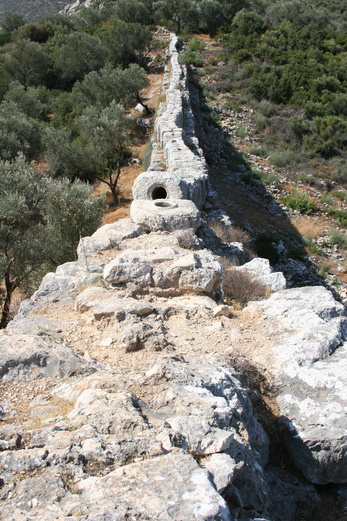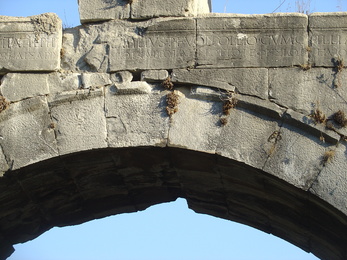
Documentation of this project
Fernwasserleitungen im kaiserzeitlichen Kleinasien. Ein Innovationsprozess und sein urbanistischer und soziokultureller Kontext
 The water pipes usually crossed deep valleys by means of an aboveground pressurized section. The pipes, as here near Patara, rested on a stone wall, but were themselves inserted into blocks of stone in order to withstand the water pressure.
The water pipes usually crossed deep valleys by means of an aboveground pressurized section. The pipes, as here near Patara, rested on a stone wall, but were themselves inserted into blocks of stone in order to withstand the water pressure. The inscription on the so-called Pollio Bridge documents in Latin and Greek the commitment of C. Sextilius Pollio in Ephesus, who paid for the construction of an aqueduct bridge clad in marble from his own pocket. Visible from afar, it crossed a much-travelled road leading to Ephesus.
The inscription on the so-called Pollio Bridge documents in Latin and Greek the commitment of C. Sextilius Pollio in Ephesus, who paid for the construction of an aqueduct bridge clad in marble from his own pocket. Visible from afar, it crossed a much-travelled road leading to Ephesus.(translated project title)
Access to clean drinking water is the epitome of basic infrastructure and is today a mandatory public duty. In Classical Antiquity, only rarely was a sufficient volume of high-quality spring water available, and it was not until Roman remote water pipes that things started to improve. Small wonder that pipe-based water supplies were something that almost every city in the Roman Empire used, despite the high costs and huge amount of labour required.
Starting from epigraphic source material, historian Dr Saskia Kerschbaum investigated the history of this form of water supply in the context of the cities in Imperial Asia Minor; her objective was to analyse the reasons for the success of the system and visualize the resulting socio-cultural change. Remote water pipes like those that were built in the days of the Roman Empire were an architectural novelty that arose from technological exchange between Rome and the Greek East. They thus offer an opportunity to trace the development of a new type of construction and the related cultural adaptation processes. Were aqueducts considered typically Roman or were they integrated, as part of the urban fabric, into how cities saw themselves? How did the cultural code inseparably linked to the edifice arise, meaning the symbolic language that was associated with the pipes?
In her analysis, Dr Kerschbaum identifies three possible actors that come into question as the developers and initiators of the infrastructural measures: the Caesars and their proconsuls, the euergetes, meaning rich citizens who wished to buy influence, and the poleis. On the basis of the dense weave of sources in Asia Minor (above all inscriptions), Dr Kerschbaum managed to specify in detail who was responsible for the spread of the remote water pipes and who paid for them. It emerged that the key role was played by the poleis themselves. The city organs were not only among the main financers but had, as a whole, to organize provision and disposal of the water and guarantee that the system functioned.
Over the course of time, regulated water supplies both with service water and decorative and recreative elements emerged as a decisive part of how cities represented and saw themselves. Contemporary authors celebrated water pipes as the perfect linkage of utility engineering and aesthetic architecture. Once erected, the aqueducts influenced not only the provision of water, but also triggered a variety of changes in almost all aspects of life: They were soon considered the basic precondition for a city offering any quality of life.
 The impressive arches of the Aqua Claudia aqueduct, a pipe running to Rome, show just how the pipes impacted on the face of the countryside. The majority of an aqueduct was subterranean, but parallel to the roads or shortly before the city was reached the pipes ran overground – no doubt for aesthetic reasons, too.
The impressive arches of the Aqua Claudia aqueduct, a pipe running to Rome, show just how the pipes impacted on the face of the countryside. The majority of an aqueduct was subterranean, but parallel to the roads or shortly before the city was reached the pipes ran overground – no doubt for aesthetic reasons, too.The rich urban upper class also participated in the field of hydraulic engineering in the cities. Unlike the poleis, the euergetes hardly funded water pipes and seem also not to have felt they were responsible for infrastructure. Their focus was on the beautiful, pleasant facilities visible in the urban fabric, such as baths and decorative fountains. The Caesar was responsible for the overall conditions. The centrally organized superstructure of the Roman Empire provided the necessary peace and legal certainty to realize such large-scale projects. Only in exceptional cases and emergencies did a Caesar or his proconsul participate directly in aqueduct construction, so there is no sign of conscious Romanization. The dominant role of the cities is specific to Asia Minor, which looked back on a centuries-old urban culture that was unprecedented in the Roman Empire.
The research findings make an important contribution to our understanding of how the cities of Classical Antiquity functioned, as well as to the processes whereby urban identities evolved, and were published as a monograph in the year under review here.
Grant holder
Dr Saskia Kerschbaum, Munich
Support
The Gerda Henkel Foundation is supporting the project by providing a PhD scholarship and covering the costs of travel and printing.
This project was documented in March 2022.

